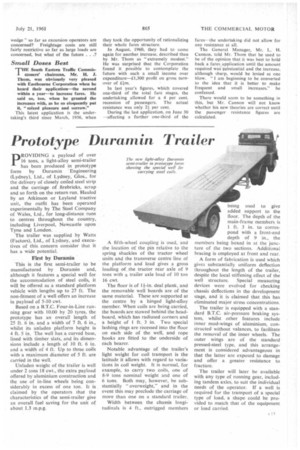Prototype Duramin Trailer
Page 51

If you've noticed an error in this article please click here to report it so we can fix it.
pROVIDING a payload of over 16 tons, a light-alloy semi-trailer has been produced in prototype form by Duramin Engineering (Lydney), Ltd., of Lydney, Glos., for the delivery of closely coiled steel strip and the carriage of firebricks, scrap and so forth on the return run. Hauled by an Atkinson or Leyland tractive unit, the outfit has been operated experimentally by The Steel Company of Wales, Ltd., for long-distance runs to centres throughout the country, including Liverpool. Newcastle upon Tyne and London. .
The trailer was supplied by Watts (Factors), Ltd., of Lydney, and executives of this concern consider that it has a wide potential.
First by Duramin
This is the first semi-trailer to be manufactured by Duramin and, although it features a special well for the accommodation of steel coils, it will be offered as a standard platform vehicle with lengths up to 27 ft. The non-fitment of a well offers an increase in payload of 5-10 cwt.
Based on a B.T.C. Four-in-Line running gear with 10.00 by 20 tyres, the prototype has an overall length of 25 ft. 6 in. and a width of 7 ft. 6 in., whilst its unladen platform height is 4 ft. 5 in. The well has a curved base, lined with timber slats, and its dimensions include a length of 10 ft. 6 in and a width of 4 ft. Up to three coils with a maximum diameter of 5 ft. are carried in the well.
Unladen weight of the trailer is well under 2 tons 18 cwt., the extra payload offered by aluminium construction and the use of in-line wheels being considerably in excess of one ton. It is claimed by the operators that the characteristics of the semi-trailer give an overall fuel saving for the unit of about 1.3 m.p.g. A fifth-wheel coupling is used, and the location of the pin relative to the spring shackles of the tractor wheel units and the transverse centre line of the platform and load gives a gross loading of the tractor rear axle of 9 tons with a trailer axle load of 10 ton 16 cwt.
The floor is of 11-in, deal plank, and the removable well boards are of the same material. These are supported at the centre by a hinged light-alloy member. When coifs are being carried, the boards are stowed behind the headboard, which has radiused corners and a height of I ft. 3 in. Two special lashing rings are recessed into the floor on each side of the well, and rope hooks arc fitted to the underside of each bearer.
Notable advantage of the trailer's light weight for coil transport is the latitude it allows with regard to variadons in coil weight. It is normal, for example, to carry two coils, one of 8-9 tons nominal weight and one of 6 tons. Both may, however, he substantially "overweight," and in the event this may preclude the carriage of more than one on a standard trailer.
Width between the chassis longitudinals is 4 ft., outrigged members being used to give added support to the floor. The depth of the main-frame members is 1 ft. 3 in. to correspond with a front-end depth of 9 in., the members being boxed in at the juncture of the two sections. Additional bracing is employed at front and rear.
A form of fabrication is used which gives substantially uniform deflection throughout the length of the trailer, despite the local stiffening effect of the well structure. Special measuring devices were evolved for checking chassis deflections in the development stage, and it is claimed that this has eliminated major stress concentrations.
The trailer is equipped with a standard B.T.C. air-pressure braking system, whilst other features include inner mud-wings of aluminium, constructed without valances, to facilitate the removal of the inner wheels. The outer wings are of the standard pressed-steel type, and this arrangement is considered advantageous in that the latter are exposed to damage and offer a greater resistance to fracture.
The trailer will later be available with any type of running gear, including tandem axles, to suit the individual needs of the operator. If a well is required for the transport of a special type of load, a shape could be provided to match that of the equipment or load carried.
























































































































